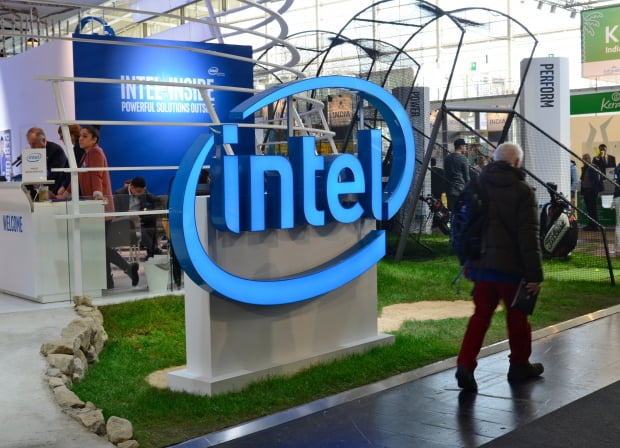
Photo = EPA
The world’s largest integrated semiconductor company (IDM) Intel, which has faced various crisis theories for several years as the semiconductor supply shortage is intensifying around the world, threw a match.
It will invest about 22 trillion won ($20 billion) to establish two new semiconductor factories in Arizona, and to enter the foundry (semiconductor consignment production) market led by TSMC and Samsung Electronics in Taiwan. Intel shares surged 6.3% after the announcement of new investments on the same day.
Pat Gelsinger, Intel’s CEO, held a global media briefing online at 6 a.m. (Korean time) on the 24th and announced the vision of’IDM 2.0′ containing such a plan. This is the first official ceremony for the CEO of Gelsinger, who took office in February following former CEO Bob Swan.
According to the IDM 2.0 vision, Intel will reenter the foundry business. Intel’s new semiconductor foundry subsidiary was decided to be’Intel Foundry Services’. It is expected to be led by Intel’s senior vice president, Landier Thakur. In the past, Intel entered the foundry business in 2016 and withdrew after two years.
Gelsinger said, “Instead of focusing on semiconductor design, we will cooperate with semiconductor companies that outsource production to produce the semiconductors they designed instead.” “We will provide the world’s largest intellectual property (IP) to our customers.” Said. Intel plans to expand its foundry business through cooperation with IBM in R&D such as packaging and Cadence and Synopsis in the design field.

Pet Gelsinger, CEO of Intel/Photo Credit=Intel
Gelsinger CEO said, “Intel Foundry Service will manufacture a variety of chips such as mobile architecture ARM technology-based chips, such as smartphones used in mobile devices, and x86 chips, which are its own architecture.” (MS), Qualcomm, Apple, etc.,” he said. These are major customers of TSMC and Samsung Electronics, which are the No. 1 and 2nd in the foundry market.
For this, Intel announced that it will establish two new semiconductor factories in Arizona and invest at least 22.6 trillion won for this. Based on the two newly planned fabs, Intel plans to meet the growing needs of its customers worldwide and provide capabilities for foundry customers.
Intel currently operates four factories in the United States called’wafer fabs’ and a single fab in Ireland, Israel and China. In addition, when two semiconductor factories in Arizona go into operation, it is analyzed that competition will intensify as they emerge as Asian semiconductor substitutes in the US and Europe. “We will secure semiconductor manufacturing facilities in the US and Europe as well,” said Gelsinger’s CEO.
On the day, Gelsinger CEO said, “We believe that it is important to maintain product optimization and delivery stability, so we will strategically utilize TSMC, Samsung Electronics, and UMC.” Although some suggested strengthening, it is analyzed that in the semiconductor industry, in many ways, Intel’s announcement is aimed at TSMC and Samsung Electronics, which are in fact the first and second foundry companies in many ways.
Reuters said, “Intel’s new factory in the US is aimed at TSMC and Samsung Electronics, Taiwan Semiconductor, which dominated the foundries of global semiconductors.” Gelsinger’s roadmap focuses on maintaining the’own production’ basis, such as expanding the manufacturing capacity through large-scale expansion, re-entering the foundry business, and revealing its own intention to produce a central processing unit (CPU), which was expected to be partially commissioned .

Intel Ocotillo Fab/Photo Credit=Intel
Currently, Intel is facing various crisis theories. The emergence of emerging CPU powerhouses such as AMD is taking away market share, and major large customers such as Apple and Microsoft announced their separation from Intel and developed their own chips. Because there is.
In recent years, Intel has also struggled to convert the process from a 14-nanometer (nm) chip to a 10-nano chip. TSMC and Samsung Electronics have reached the 5nm level beyond 7nm. As if conscious of this, Gelsinger’s CEO said on the day, “We are preparing well for the 7-nano process. We are also working with ASML to increase the utilization of extreme ultraviolet (EUV) technology.”
Meanwhile, Intel’s announcement of large-scale production expansion was made while the US government prepared various measures to overcome the semiconductor crisis. Earlier, U.S. President Joe Biden said last month that domestic semiconductor manufacturers are a top priority by the administration, and decided to review additional government support and new policies to expand U.S. semiconductor production in order to solve the shortage of semiconductors. CNBC predicted that the U.S. government would give Intel huge benefits, such as tax assistance.
Seongsu Bae, reporter of Hankyung.com [email protected]
